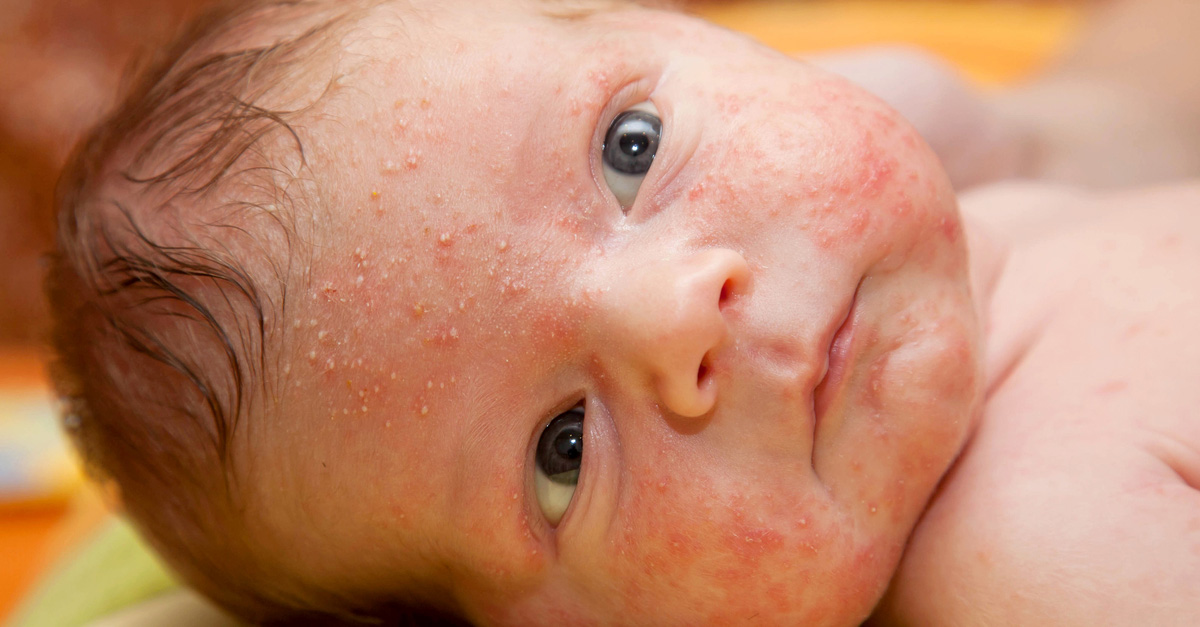Summary
- Baby acne is a very common rash in newborns, affecting 20-30% of all babies.
- It is harmless and will go away on its own without any treatment, usually by 4 months of age.
- No treatment is necessary. Avoid oils and lotions on the skin and clean with gentle soap and water.
- Hydrocortisone or ketoconazole cream can be used to treat it but it is not necessary.
There are a lot of rashes that babies get that are common and perfectly normal. Some are thought to be due to changes in the skin as the baby transitions to living outside the womb, as well as the effects of maternal hormones on their skin. One common rash appears as bumps on the forehead and face and is usually called baby acne. For many years, it was thought to be a form of acne due to the high level of hormones that babies have through the placenta. However, it is now believed that this is a separate rash, and while a very few babies may get true acne, the common newborn rash is not acne and has been renamed neonatal cephalic pustulosis. Some also call it neonatal acne, to distinguish it from true acne which appears at several months of age and is called infant acne. Infant acne is a more serious condition than baby or newborn acne. About 20-30 percent of infants get baby acne (neonatal cephalic pustulosis). Some, however, use this term to refer to a fungal infection of the skin in some infants, though some studies have shown no association between this yeast and baby acne. Experts differ on their opinion as to the cause and what names to call this common condition. It may be that there are multiple conditions/causes which appear very similar on the newborn’s skin.
What are the symptoms of baby acne?
- Small red bumps scattered over the forehead, face, and scalp.
- They also appear on the ears, neck, upper chest and back.
- There may be white pustules in the center that look more like teenage acne pimples, especially on the cheeks.
- It usually starts around 2-3 weeks of age.
What causes baby acne?
Some think it is caused by maternal hormones, and the normal skin changes that infants go through as they transition from living in liquid to living in air. Others believe that it is due to a yeast on the skin (Malassezia), although studies are not consistent on the presence of this yeast in babies with newborn acne. (It may be that there is more than one cause/condition at work here).
What should I expect?
- It usually starts around 2-3 weeks old on the forehead and cheeks. It can spread to the ears, neck, upper chest and back.
- It usually goes away by 4 months of age.
- It may come and go, and can be worsened by lotions or irritants which come into contact with the skin.
How is it treated?
- Treatment is not necessary. It is harmless and will go away on its own. It will not leave any scars.
- Avoid baby oils and lotions; these can make it worse.
- Gently clean your baby face with water and gentle baby soap*.
- Hydrocortisone 1% cream once a day may help with the rash. It is available over-the-counter in many different brands, usually store brands.
- Some dermatologists recommend ketoconazone (anti-fungal) 2% cream twice a day. It is also available over-the-counter. It does help in some cases (if Malassezia is involved. There is no test for this.) However, since there is no real evidence that it is caused by this fungus, and since it resolves on its own, I do not recommend this treatment.
What complications should I look for?
- Skin infection, with deeper, larger, painful area of redness, possibly with drainage of pus.
- Acne rash appearing after 2 months old that has blackheads and more severe pimples is a more serious condition that needs to be evaluated and treated.
How can newborn acne be prevented?
There is no way to prevent it. Avoid oily and greasy products on the face which can make it worse.
When should I seek further care?
- If there are any signs of infection as described above.
- If the rash has blackheads and more severe pimples.
- If the rash is worsening, or lasts past 6 months of age, or there are any signs of puberty, such as pubic or armpit hair.
For more information
References
- Samycia M, Lam JM. Infantile acne. CMAJ. 2016;188(17-18):E540. doi:10.1503/cmaj.160139
- Eichenfield LF, Krakowski AC, Piggott C, et al. Evidence-Based Recommendations for the Diagnosis and Treatment of Pediatric Acne. Pediatrics. 2013;131(Supplement 3):S163-S186. doi:10.1542/peds.2013-0490B
1/31/2005
Last updated: 4/11/2020
Last reviewed: 4/11/2020


